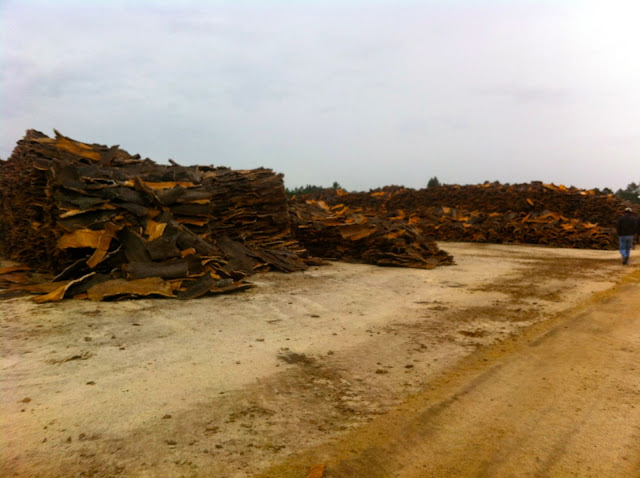The second day in Lisbon we drove east to the forests where the raw material is harvested and seasoned. These are messy piles of raw material.
The bottom of the tree has the highest incidence of TCA. It's generally wetter and more hospitable to fungal growth. However, it is not possible to leave this part on the tree and only harvest the top, so the entire portion is harvested and later workers cut the "foot" off the bark (the bottom 9 inches).
After the "foot" is cut off (seen here) the bark is quickly sorted into "thin", "medium" or "thick". The sorted piles are then stacked neatly.
Here thick and thin pieces are all piled together, not yet sorted.

This pile is bark of similar thickness. These piles are left outside for a minimum of 6 months to "season". This time allows the bark to equilibrate and get more uniform humidity.
The piles must be left outside, unfortunately it rains and high moisture is an ideal condition for additional fungal growth, so they slope the top in an effort to drain some of the rain water that the wood collects.
When they are ready to process the bark they bring the piles inside to be boiled. The boiling process kills the fungus that is present. This also allows the bark to expand, becoming more pliable and easier to work with. In this picture the wood has just come out of the boiler and is still steaming. They do a first boil for 90 minutes at 100C and then a second boil for 45 minutes.

After the planks are boiled another person cuts them into more workable pieces. He is also deciding where to cut the pieces; cutting off an ugly chunk can increase the overall quality of a plank. The prettier the piece, the higher quality cork that can be punched from it. The rejected pieces are used for shoes and other cork products.

Here are the boiled flat planks.

More boiled planks that will soon become cork stoppers.
The top piece is raw bark taken directly from the tree. The bottom piece is a sample after the raw bark from that tree has been boiled. They use this to compare how the bark expands and contracts during the boiling process, since no two trees are alike.
This gives them a reference for thickness. Cork can be harvested every 9 years but if the bark doesn't expand very much when boiled, they might wait more than 9 years to harvest to get the required thickness (sample 22 expanded more than 23). Or they can use the wood for discs instead of corks because discs are thinner.
Now you know more than you thought you could know about knowing what you did not know.
Next week I'll talk about how the corks get punched and visit a factory where they make champagne corks!
-L








No comments:
Post a Comment